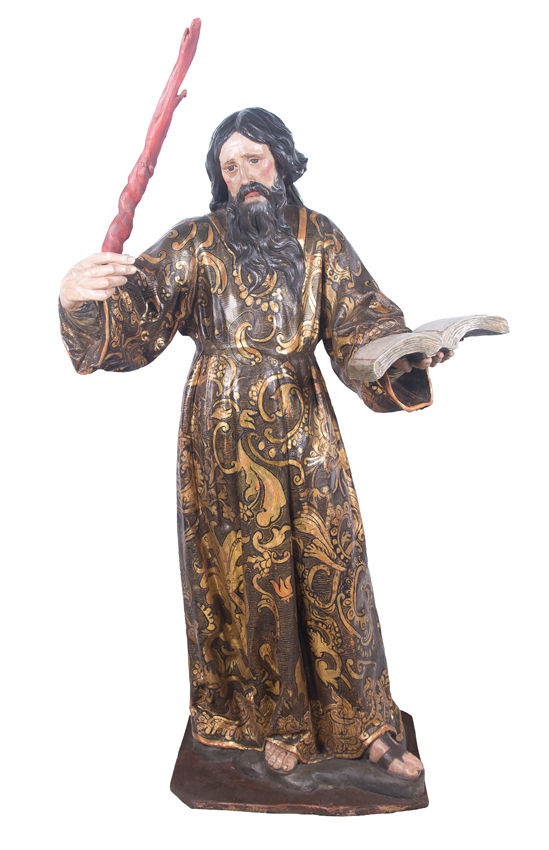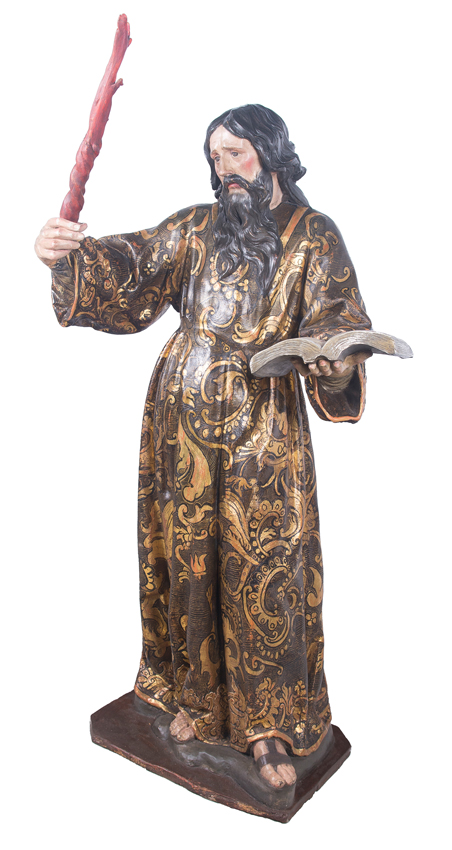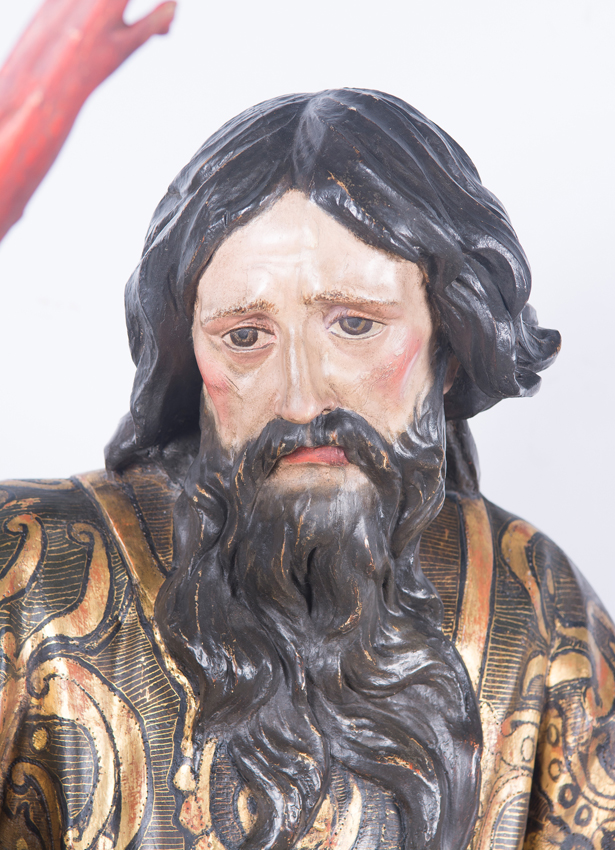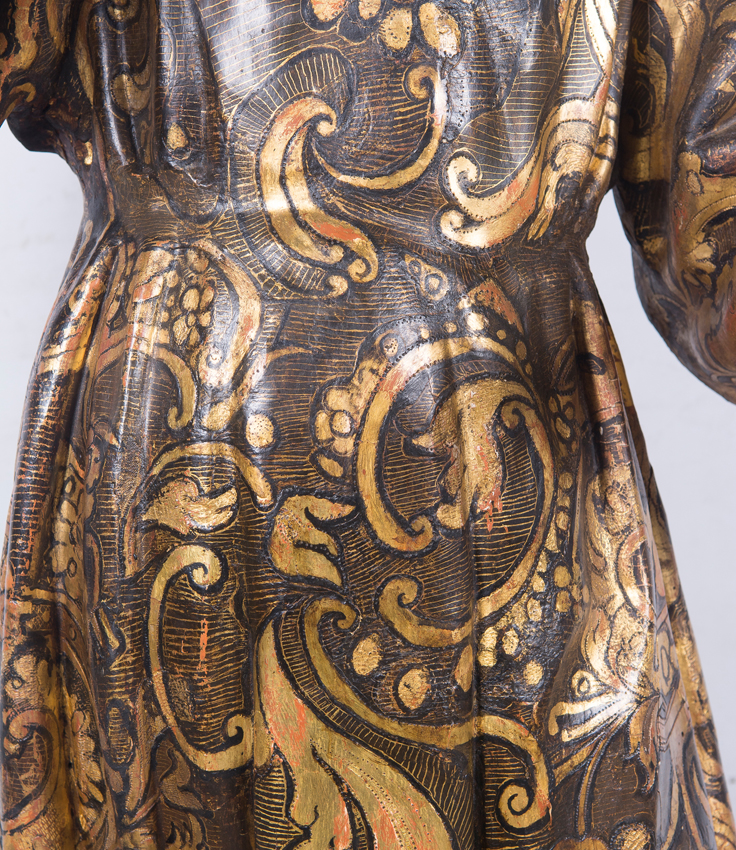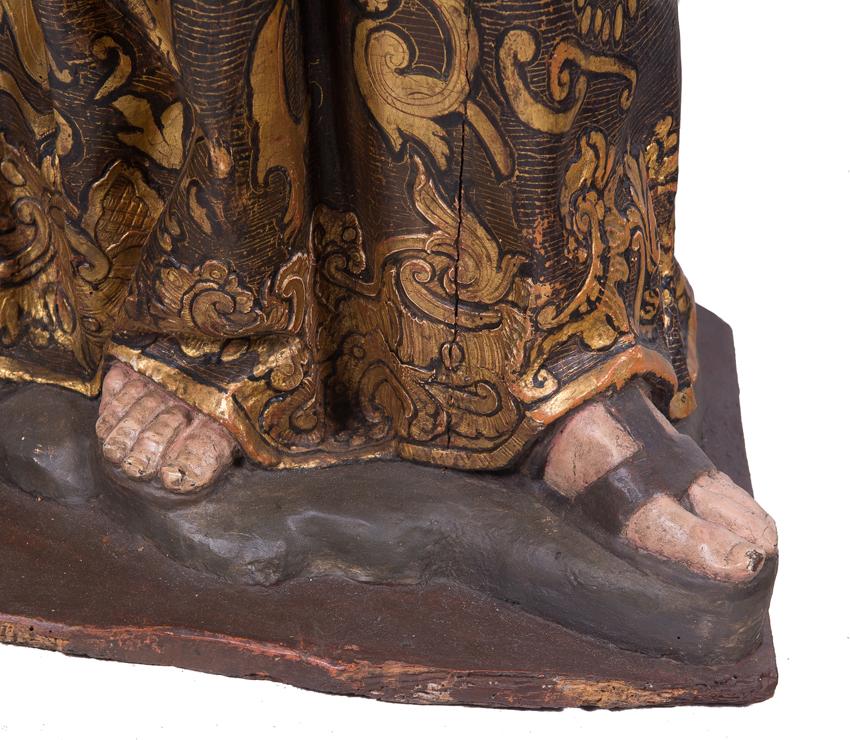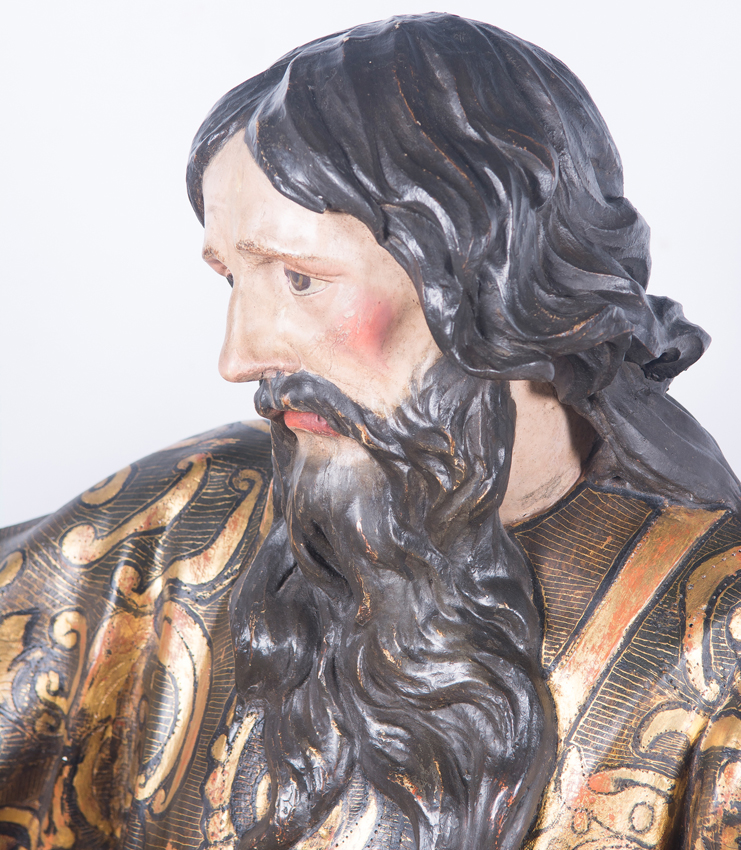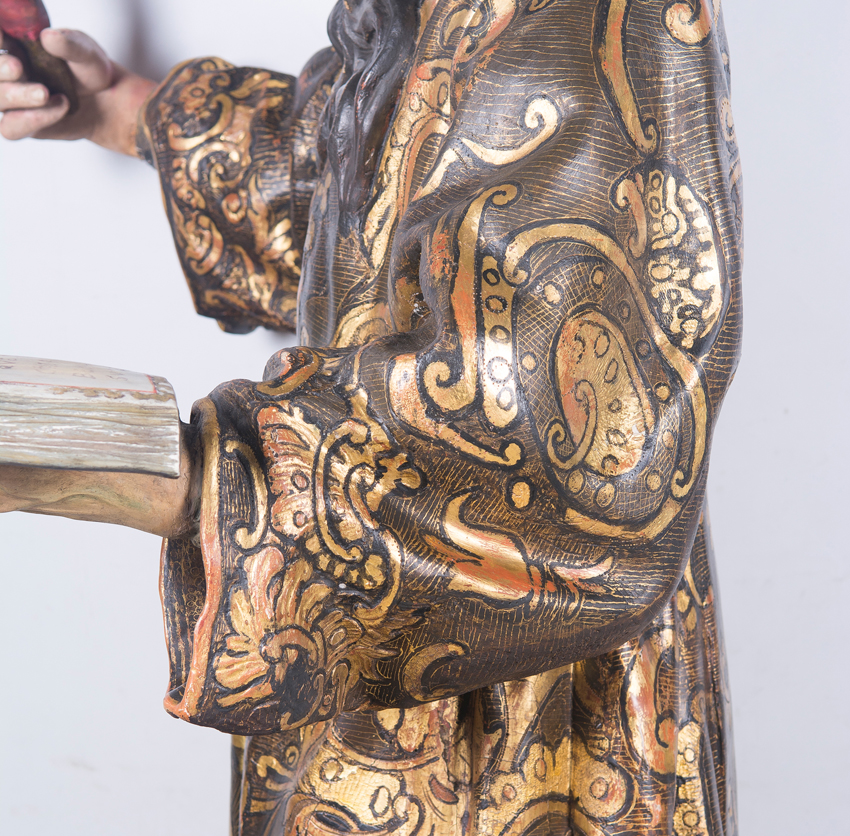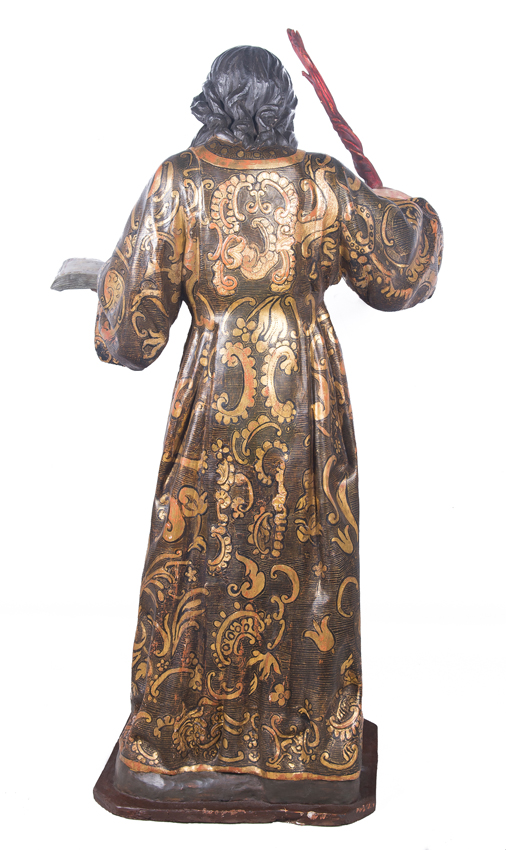25
Attributed to José de Arce (Flanders, circa 1600 - Seville, 1666)
Attributed to José de Arce (Flanders, circa 1600 - Seville, 1666)
"Saint Elijah"
Carved, stewed and polychromed wooden sculpture. Circa 1649 - 1666.
This sculpture of Saint Elijah is an exquisite piece recently attributed to the remarkable Flemish sculptor who was based in Seville, José de Arce (ca. 1607-1666). He was a master who brought another twist to the process of making the Sevillian sculptural School more baroque by introducing novelties from European Baroque and some of its characteristics, such as the pleat or the Bernini fold, named after the Italian sculptor. The piece has been attributed to Arce by the researcher José Manuel Moreno Arana, who also asserts that it was created between the years 1649-1666.
The prophet Elijah is, after Moses, the most important figure in the Old Testament. His name means "Yahweh is my God." He dedicated his life to fighting for Yahweh against Baal.
Although the sculpture is currently in a private collection in Jerez de la Frontera, its origin can be traced back to one of the two Carmelite monasteries (Saint Elijah was considered to be the founder of this Order, as he lived in a cave on Mount Carmel, where a community of hermits, according to tradition, represented the continuity of eremitic life since the time of the prophet, keeping his spirit alive. Such is the connection between the saint and the Order that it is also known as the Ordo Elianus) that existed in Seville: the Casa Grande del Carmen and the College of San Alberto. After the confiscation of church property in 1835, the sculpture was transferred to the Convent of Buen Suceso and from there, before ending up in the private collection, it was taken to a monastery in the town of Carmona, founded in the 20th century.
The image of Saint Elijah was probably made to be placed in an altarpiece, and furthermore, in a large one, given that he was, as we have seen, one of the most renowned Carmelite saints. It is life-size and follows the traditional iconography of the saint: he is depicted standing, wearing a simple tunic with rounded vertical folds tightly cinched at the waist, and a small camel fur mantle covering his back. In his right hand, he wields the flaming sword with which he defeated the prophets of Baal on Mount Carmel, while in his left hand, he holds an open book that alludes to his role as the "founder" of the Carmelite Order, although it could also represent his book of prophecies. The face, kind yet energetic, is of exquisite quality as the sculptor has made the wood resemble flesh by giving softness and delicacy to the skin. Palpable examples are the wrinkles and corresponding indentations on his cheeks, indicating the saint's old age. He has a roughly sketched asymmetric hairstyle, which yet conveys notable dynamism and realism. The raised eyebrows give determination to his countenance, his eyes are painted directly on the wood and are meticulously carved with detailed eyelids. He has a strong nose with a straight outline, a characteristic feature of the Flemish-Sevillian sculptor's style, a small slightly open mouth, and long moustache and beard crafted in large, highly dynamic masses that create chiaroscuro effects, thus reinforcing the volume of the head. It is reminiscent of other documented works by the aforementioned sculptor, such as the stone images he carved for the Sagrario church belonging to Seville Cathedral or the wooden ones for the Carthusian monastery in Jerez. The hands and fingers exhibit remarkable anatomical accuracy, meticulously detailing the nails, veins, joints (the knuckles are very prominent), and muscles. The partially visible feet are protected by humble sandals.
The sculpture no longer retains its original polychrome, as it was repainted during the Rococo period, specifically around the years 1760-1770. There is abundant use of gold, vegetation decorations, and the techniques of stippling and lustre painting.
We would like to thank Dr. Javier Baladrón, doctor in Art History, for the identification and cataloguing of this work.
Attributed to José de Arce (Flanders, circa 1600 - Seville, 1666)
"Saint Elijah"
Carved, stewed and polychromed wooden sculpture. Circa 1649 - 1666.
This sculpture of Saint Elijah is an exquisite piece recently attributed to the remarkable Flemish sculptor who was based in Seville, José de Arce (ca. 1607-1666). He was a master who brought another twist to the process of making the Sevillian sculptural School more baroque by introducing novelties from European Baroque and some of its characteristics, such as the pleat or the Bernini fold, named after the Italian sculptor. The piece has been attributed to Arce by the researcher José Manuel Moreno Arana, who also asserts that it was created between the years 1649-1666.
The prophet Elijah is, after Moses, the most important figure in the Old Testament. His name means "Yahweh is my God." He dedicated his life to fighting for Yahweh against Baal.
Although the sculpture is currently in a private collection in Jerez de la Frontera, its origin can be traced back to one of the two Carmelite monasteries (Saint Elijah was considered to be the founder of this Order, as he lived in a cave on Mount Carmel, where a community of hermits, according to tradition, represented the continuity of eremitic life since the time of the prophet, keeping his spirit alive. Such is the connection between the saint and the Order that it is also known as the Ordo Elianus) that existed in Seville: the Casa Grande del Carmen and the College of San Alberto. After the confiscation of church property in 1835, the sculpture was transferred to the Convent of Buen Suceso and from there, before ending up in the private collection, it was taken to a monastery in the town of Carmona, founded in the 20th century.
The image of Saint Elijah was probably made to be placed in an altarpiece, and furthermore, in a large one, given that he was, as we have seen, one of the most renowned Carmelite saints. It is life-size and follows the traditional iconography of the saint: he is depicted standing, wearing a simple tunic with rounded vertical folds tightly cinched at the waist, and a small camel fur mantle covering his back. In his right hand, he wields the flaming sword with which he defeated the prophets of Baal on Mount Carmel, while in his left hand, he holds an open book that alludes to his role as the "founder" of the Carmelite Order, although it could also represent his book of prophecies. The face, kind yet energetic, is of exquisite quality as the sculptor has made the wood resemble flesh by giving softness and delicacy to the skin. Palpable examples are the wrinkles and corresponding indentations on his cheeks, indicating the saint's old age. He has a roughly sketched asymmetric hairstyle, which yet conveys notable dynamism and realism. The raised eyebrows give determination to his countenance, his eyes are painted directly on the wood and are meticulously carved with detailed eyelids. He has a strong nose with a straight outline, a characteristic feature of the Flemish-Sevillian sculptor's style, a small slightly open mouth, and long moustache and beard crafted in large, highly dynamic masses that create chiaroscuro effects, thus reinforcing the volume of the head. It is reminiscent of other documented works by the aforementioned sculptor, such as the stone images he carved for the Sagrario church belonging to Seville Cathedral or the wooden ones for the Carthusian monastery in Jerez. The hands and fingers exhibit remarkable anatomical accuracy, meticulously detailing the nails, veins, joints (the knuckles are very prominent), and muscles. The partially visible feet are protected by humble sandals.
The sculpture no longer retains its original polychrome, as it was repainted during the Rococo period, specifically around the years 1760-1770. There is abundant use of gold, vegetation decorations, and the techniques of stippling and lustre painting.
We would like to thank Dr. Javier Baladrón, doctor in Art History, for the identification and cataloguing of this work.
Routes of Art
Sale Date(s)
Indirizzo della sede
General delivery information available from the auctioneer
The purchase price includes the delivery of the lots in the venue of the auction. Transporting to other destinations is at the own risk of the client. The customer must contact "LST", to give the corresponding instructions for such transporting. "LST" is not responsible for the packaging or any accident incurred during transportation.
Informazioni importanti
For buyer’s premium and VAT please check particular lot.
Zu Aufgeld und Mehrwertsteuer prüfen Sie bitte das jeweilige Los.
Termini e condizioni
CONDITIONS OF THE AUCTION:
I. REGISTRATION. To bid in the room customers must register at the beginning, filling out a form and picking a number that will identify them during the auction. Customers may be required to register in bank references or other guarantee system and if they do not prove the solvency "LST" will not accept bids and award the auction.
II. WRITTEN BIDS. "LST" will accept written bids, which will be formalized in the form provided by the room until the day before the auction. In such auctions, the room will bid in name of the client until the maximum stated in the offer and always at the lowest possible price. If there are two or more bids for the same amount, the one placed first will have the priority. Written bids received in advance, will have priority on the day of the auction.
III. TELEPHONE BIDS. "LST" will allow telephone bids, if interested people contact "LST" days before the auction providing personal data, ID card and the phone number which will be used by the staff of "LST" to call at the time of the auction. The buyer, within all the legal rights is making an offer for the asking price, when applies for telephone bid. "LST" will not take responsibility for any technical defects beyond its control, which may prevent to contact successfully the bidder during the auction.
IV. AUCTIONEER. The auction will be conducted by an auctioneer, director of the auction will be judge and arbitrator of it with full authority in its development, will award the lots to the highest bidder and is able to settle any controversy concerning lots sale, reject bids, divide lots or group them and remover objects from the room. Will be able to, if it is deemed suitable, not accept bids on the auction. His decision will be unappealable.
V. SALE OF LOTS. The lots are awarded to the highest bidder. Once the auctioneer blows the hammer, the buyer becomes responsible of the lot purchased, exempting "LST" of liability to for any damage and / or accidents that may occur. No refunds of lots.
VI. STARTING PRICE. The amount shown in the catalogue as the starting price for each lot will be, as a rule, the minimum selling price, except for exceptional cases where a reservation may be agreed upon with the seller or it set discretionary by the room.
VII. SCALE OF BIDS. The bids are set according to the following scale:
From 50.-€ to 200.-€…………………………………………..at 10.-€
From 200.-€ to 500.-€…………………………………… …25 in 25.-€
From 500.-€ to 1.000.-€………………………………..…..….50 in 50.-€
From 1.000.-€ to 2.000.-€………………………………..…100 in 100.-€
From 2.000.-€ to 5.000.-€……………………………….….250 in 250.-€
From 5.000.-€ to 10.000.-€…………………………………500 in 500.-€
From 10.000.-€ to 20.000.-€……………………………1.000 in 1.000.-€
From 20.000.-€ to 50.000.-€……………………………2.500 in 2.500.-€
From 50.000.-€ to 100.000.-€…………………………..5.000 in 5.000.-€
From 100.000.-€ to 100.000.-€………………………10.000 in 10.000.-€
From 200.000.-€ to 200.000.-€………………………25.000 in 25.000.-€
From 500.000.-€ to 500.000.-€………………………50.000 in 50.000.-€
VIII. RIGHT OF ADMISION. "LST" reserves the right to admission to the auction room and to reject, at its judgment, any purchase order, from clients whose solvency is not duly proved as well as not to sale auctions.
IX. SALE PRICES. The successful bidder of one or more lots must pay "LST" the final sale price achieves at auction, plus the 22 % plus 21% VAT on the commission, at total 26,62 % on Hammer Price.
X. CATALOG DATA. The catalogue data are obtained in order to careful research and advice, however, any responsibility is afforded about its accuracy. The lots will be auctioned in the state in which they are, not accepting any claims in restorations, breakage, damage, imperfections and, even description or numbering mistakes in the catalogue, in case of it, being the burden of the buyers to make sure before the auction that the description matches with their personal opinion about respective lot. The exhibition of the lots is intended to allow a perfect review and study of them.
XI. PAYMENT AND REMOVAL OF LOTS. Payment and removal of the lots will be held no later than five days following the auction. After this period expire without having the buyer removed the lot or lots purchases, it will accrue an expense of custody of 6 euros per day on each lot.
15 days after the auction without having the buyer paid and removes the sold lots, "LST" will inform the seller and there will begin judicial proceeding in order to obtain payment. The delay in payment by the purchaser of his/her sold lots will carry an interest increase at a rate of 1,5% per month.
XII. DELIVERY OF LOTS. The purchase price includes the delivery of the lots in the venue of the auction. Transporting to other destinations is at the own risk of the client. The customer must contact "LST", to give the corresponding instructions for such transporting. "LST" is not responsible for the packaging or any accident incurred during transportation.
XIII. RIGHT OF FIRT REFUSAL AND REPURCHASE. "LST" in order to article 38 of "Ley 16/1985 de 25 Junio del Patrimonio Histórico Español" (BOE. 155 June 29, 1985), will notify in advance to the Ministry of Culture, the content of their catalogues. Concerning the lots subject to the legislation referred to in the preceding paragraph, the Administration may exercise the rights of first refusal and repurchase according to the law. "LST" will watch over the protection of Artistic, Historical and Bibliographical Heritage of Spain. For customers out of European Community, a tax for export is required by the Administration.
XIV. VALUE ADDED TAX (I.V.A). This tax will be accrued on commissions of "LST" for buyers, using the rates prevailing on the date of the auction.
XV. DATA PROTECTION. In order to the "Ley 15/1999 de 13 de Diciembre, de Protección de Datos de Carácter Personal", the client authorize "LST", the inclusion of their data in a customer file, and for the promotion by "LST" of the objects at all times the rights of access, rectification or deletion of personal data by sending the appropriate request to the following address: LA SUITE SUBASTAS, C/ Conde Salvatierra, 8, 08006. Barcelona.
XVI. EXPRESS LEGAL JURISDICTION. These Conditions are governed by and interpreted in accordance with the rules of Spanish law. The mere act of participating in the auction as seller, buyer or bidder, implies acceptance of these Terms and Conditions.
Sales operations are understood to be held at the registered office of "LST", C/ Conde de Salvatierra, 8, 08006. Any dispute shall be taken to the competent courts of Barcelona, expressly waiving any other jurisdiction, in accordance with Article 55 of the "Ley de Enjuiciamiento Civil".

















